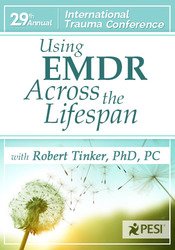Description
This is will be a discussion of research starting at age one and ending with issues related to dying, EMDR can be effective across a wide spectrum of human problems. We will examine how EMDR is used with traumatized children, in phantom limb pain, after motor vehicle accidents and other discrete traumatic experiences, in dissociative clients, and with pain issues, using data from scientific studies, videotaped demonstrations and case histories. We not only have brain pre-and post- neuroimaging studies of EMDR treatment, but also have been able to demonstrate neurobiological shifts during the session itself, making EMDR a form of treatment with neurobiological shifts within a single session, as well as over time; not only with PTSD, but also in phantom limb pain.
CPD
CPD
- PESI Australia, in collaboration with PESI in the USA, offers quality online continuing professional development events from the leaders in the field at a standard recognized by professional associations including psychology, social work, occupational therapy, alcohol and drug professionals, counselling and psychotherapy. On completion of the training, a Professional Development Certificate is issued after the individual has answered and submitted a quiz and course evaluation. This online program is worth 5.75 hours CPD for points calculation by your association.
Faculty
Robert Tinker, PhD, PC, has specialized in EMDR for 26 years in areas of writing, research, consultation, training and clinical practice. He is the author of Through the Eyes of a Child: EMDR with Children.
Objectives
- Summarize the biological nature of trauma and how trauma can create physical and psychological symptoms to better understand your clients.
- Explain how EMDR is used for processing traumatic memories as it relates to clinical practice.
- Evaluate research of the effectiveness of EMDR with clients aging across the lifespan.
- Examine the research that suggestions EMDR as a successful tool for the clinical treatment of phantom limb pain and as well as other pain.
- Describe how EMDR has been used to treat clients after motor vehicle accidents and other discrete traumatic experiences, in dissociative clients.
- Review the studies that show EMDR as a form of treatment with neurobiological shifts within a single session, as well as over time; not only with PTSD, but also in phantom limb pain.
- Summarize the results of neuroimaging studies that show the brain pre-and post EMDR treatment.
- Determine when/if your client is prepared to safely process trauma memories via EMDR.
Outline
Research of EMDR across the lifespan
EMDR application
- Traumatized children
- Phantom limb pain and other pain
- After motor vehicle accident or single incident trauma
- Clients with Dissociative Identity Disorder
- And more
Data and Scientific Studies
- EMDR and the Brain
- Neuroscience behind EMDR
- Neuroimaging studies comparing before/after treatment
- Evidence of Neurobiological shifts during session
Review of Client Success with EMDR
- Case studies
- Video demonstration
Target Audience
Physicians, Psychologists, Social Workers, Addiction Counselors, Counselors, Marriage & Family Therapists, Nurses, Psychiatrists, and other Mental Health Professionals

